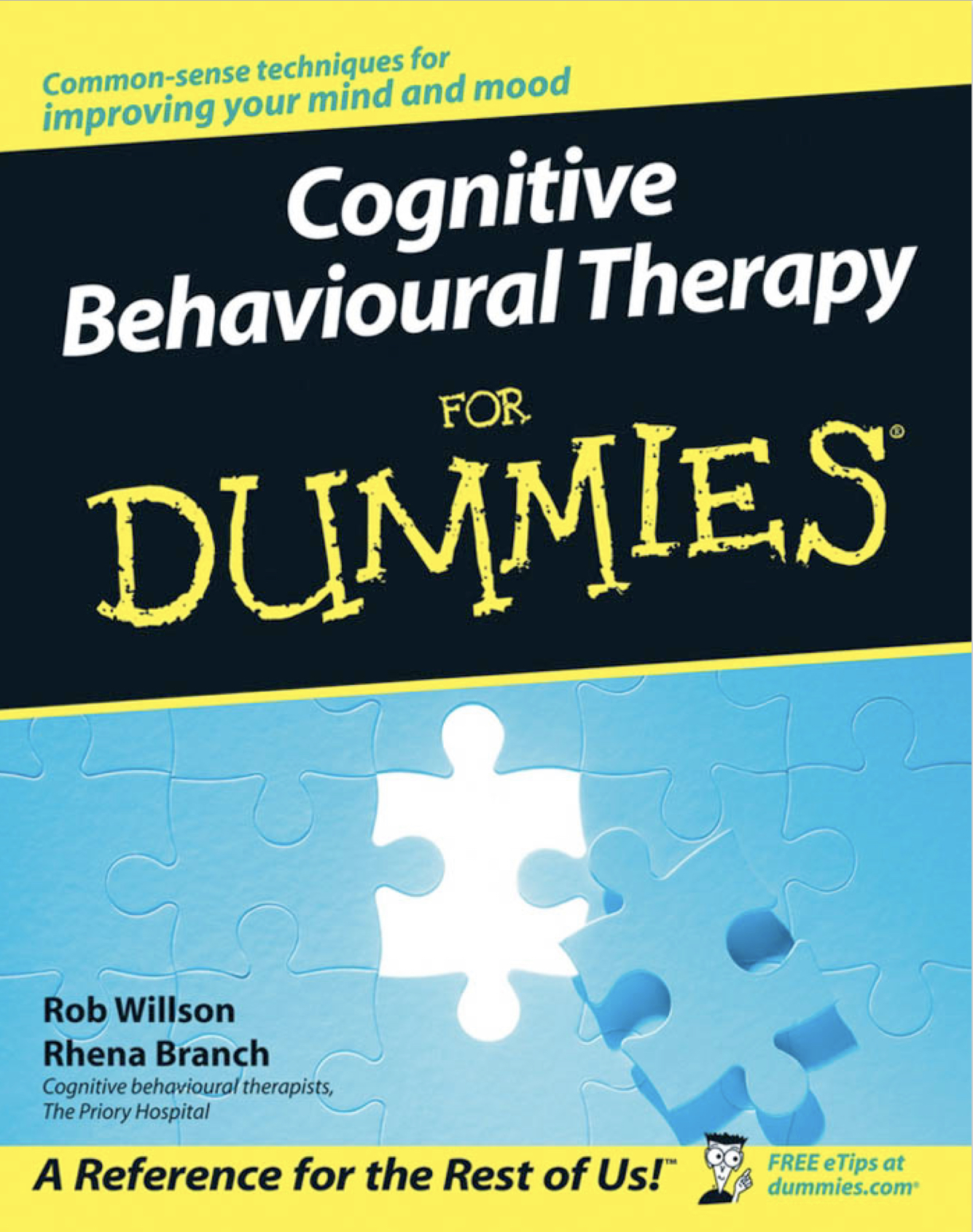Summary
One Sentence Summary
What evidence do I have to support my thinking?
One paragraph Summary
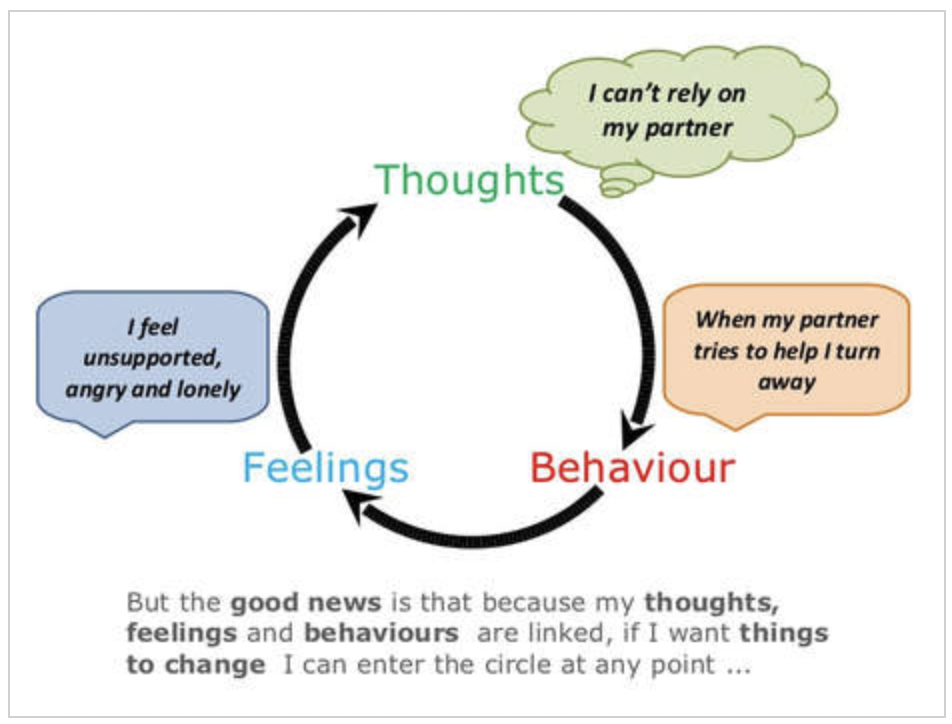
Our negative behaviors are often the result of unhealthy core beliefs, which are the product of flawed error thinking.
To identify an unhealthy core belief, start by tracking when you become emotionally triggered by an event (past, present, future; real or fictional); write down the issue on paper and ask yourself what this event says about you, other people, and the world, and notice the negative behaviors that follow.
Once an unhealthy core belief is identified, we are now in a position to cultivate less absolute, more accurate, more realistic opinions about yourself, other people, and the world around you by conducting hypothesis testing and running experiments; this is where you generate new evidence to validate your newfound core belief.
The final and most important step is to actually take action, knowing that you may fail or relapse, but persisting forward because you are developing a new habit.
Other points
- We feel the way we think
- Ask yourself:
- “What evidence do I have to support my thinking?”
- “What evidence am I collecting to validate my thoughts (is it only the negative side)?
- “What kind of evidence are my actions producing? Is this evidence supporting a belief that I support?”
- The quality of our thinking determines the qualities of our feelings; which influence the quality of our actions
- The meanings we assign to events have a great deal to do with how we ultimately feel about those events
- This same meaning is attached to the names we call ourselves
- Fortunately, you get to choose what messages you give to yourself and, therefore, choose how you think and feel about yourself
- My one action may be silly, but it does not make me, as a collection of all my other smart moves, dumb.
- removing emotions from the equations, do you have evidence to support your thinking? Imagine your are defending your ideas in court, and only sound evidence is permissable.
What ACTIONS/HABITS will I partake after reading this book?
- In my journaling, I have added a section to include the CBT template
- When I write down emotional events, I will have templates conveniently right next to me to track my thinking.
- Whenever I’m upset, after I have done box breathing, and I think positively about my worthwhile goal, ask myself: “What evidence do I have to support my thinking?”
- DOCUMENT MY LIFE
- Build things to show and display for others to see
- Build my name with action, things that I can show
- Live your life like it’s a movie and you’re the hero!!!
- Like this blog :), it’s one aspect of that which I document
Part 1: Introducing CBT Basics
CBT is as easy as ABC. Our negative behaviors are often the result of unhealthy core beliefs, which are the product of flawed error thinking. To identify an unhealthy core belief, start by tracking when you become emotionally triggered by an event (past, present, future; real or fictional); ask yourself what this event says about you, other people, and the world, and notice the negative behaviors that follow.
Once an unhealthy core belief is identified, along with its error thinking, we are now in a position to cultivate new, healthy, alternative core beliefs by conducting hypothesis testing and running experiments to collect accurate viewpoints about the situation, and subsequently lead to more productive behaviors.
Chapter 1: You Feel the way you Think
Summary
CBT is as easy as ABC.
A is for action; take note of when you become triggered by an event, either in the present, past, or future.
B is for belief, notice how you choose to label the action/event; what does this meaning say about me? What does it say about other people? What does it say about the world?
C is for consequences, notice how your behavior manifests. Is this behavior desirable? If not, it is likely due to an unhealthy belief (core beliefs drive behaviors).
Chapter Details
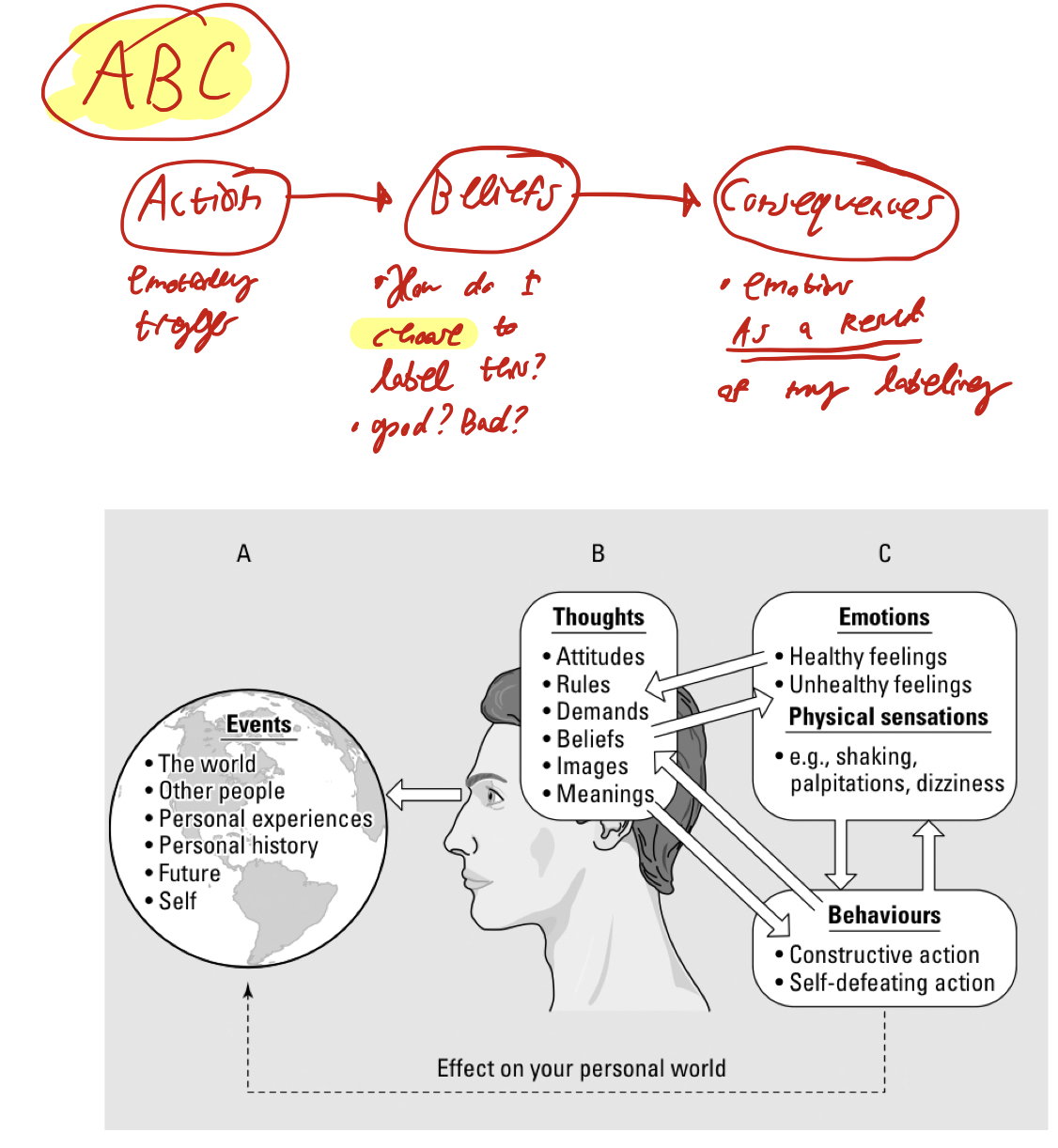
Implementing CBT is as simple as ABC:
- Action: Identify the trigger, event, or stimulus that evoked an emotional response from you
- Beliefs: How do you choose to label this event? How you label this event will determine your emotion; the label comes from your core beliefs and principles, which are amendable
- Consequences: The resulting emotions, which manifest into behavioral consequences.
Here’s a basic example: Let’s say you are leading a project, and you were unable to obtained the desired result; this results in you being placed on a different team (action).
You hold a beleif that if you were really good at your job, then you would stay with your same group; otherwise you are a loser.
Going from this belief, we have little choice but to label this event as a negative setback–one that confirms as evidence that we are losers.
What happens next? Your actions will begin acting like a loser, because your emotional state is one of a loser.
ABC. Action, Belief, and resulting Consequences.
From this framework, we see that the phrase “pain is inevitable, but suffering is optional” comes to light.
We may feel uncomfortable by an event (trigger), but we get to choose how to label that event. This is perhaps the most important step, because all the chain of events that follow are determined from this pivot point.
If we choose negative thoughts, our emotions and actions will be negative.
If we choose positive thoughts, our emotions and actions will be positive.
It’s as simple, and easy as that.
Chapter 2: Spotting Errors in Your Thinking
Summary
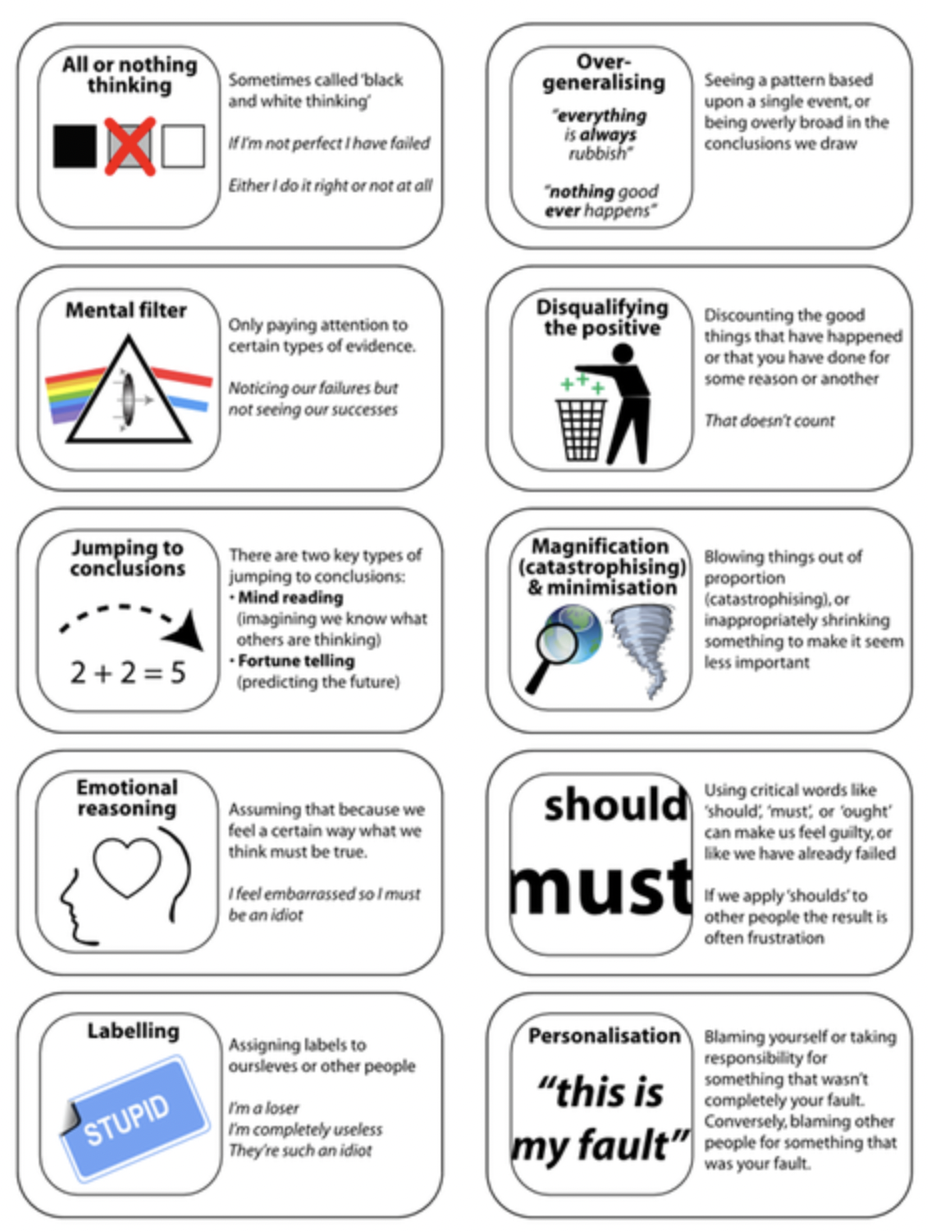
Fatal flaws of core beliefs come from thinking errors. There are 12 common thinking errors–the common theme in all of them is overweighing the negative over the positive.
Chapter Details
Here’s a list of the common thinking errors.
- Catastrophising
- All or nothing Thinking
- Mind Reading
- Emotional Reasoning
- Overgeneralizing
- Labeling
- Demands (“have to”)
- Filtering
- Disqualifying the positive
- Low fault tolerance
- Personalizing
- Fortune Telling
Here’s what all of these error thinkings have in common: We give far more weight to the negative than we do to the positive.
Chapter 3: Tackling Toxic Thoughts
Summary
Keeping track of when we get triggered, and our negative consequences/behaviors, is simple way of identifying the unhealthy core belief.
Chapter Details
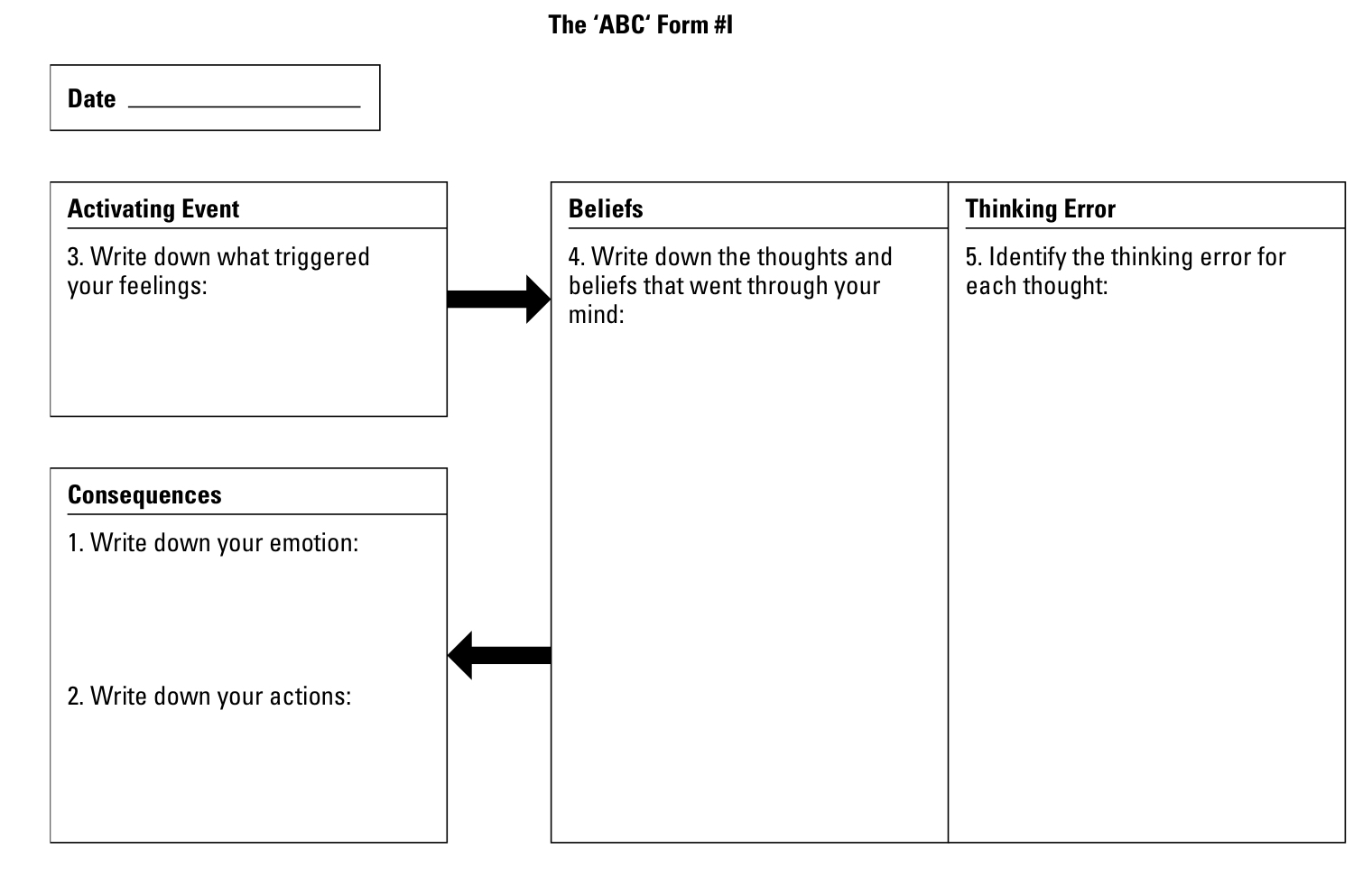
We discover a neat framework for fine-tuning our ABC method.
- Write down the emotion we feel from the action
- Get creative! There are multiple degrees of emotions (anger, jealously, shame, envy, guilt, etc)
- Write down how you acted
- Did you avoid something? Become aggressive? Become isolated? What about procrastination?
- What exactly is triggering your emotions?
- This is actually a good order, because in real life, we get emotional first, and then have to figure out what happened
- It does not have to be a current event! It can be something from the past, or something you’re anticipating in the future! It might even be body sensations (maybe you ate something, and you feel lethargic because of high insulin). Sometimes it does not come from something harmful, but something different, and you may discover that it’s actually not that bad!
- Write down how you label this event (thoughts, beliefs, and attitudes)
- Be honest. Are you feeling like a loser? Then write that down.
- Identify which thinking error is the culprit of your negative thoughts
For more in-depth analysis, there’s another form below.
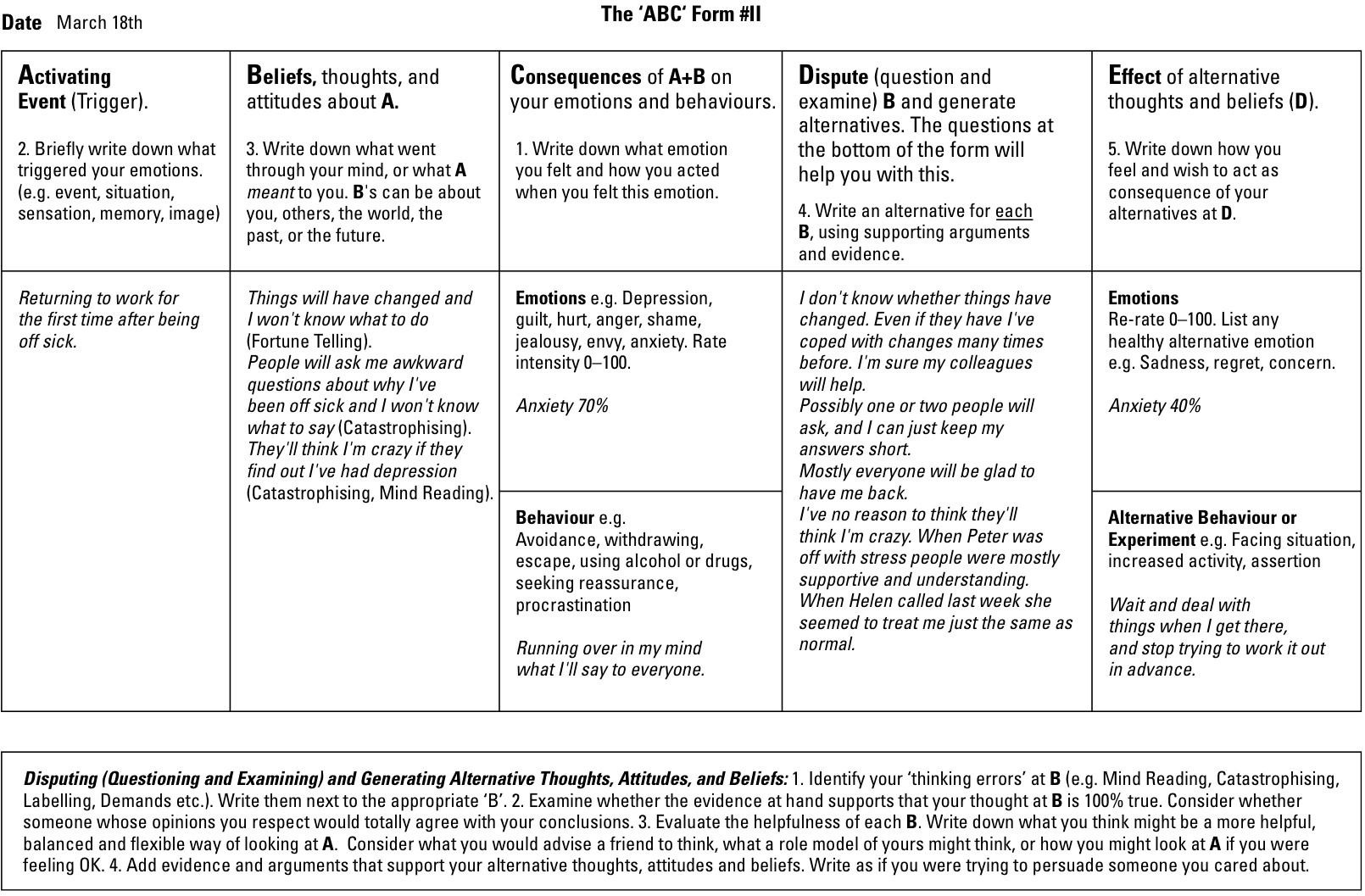
- Examine your negative thoughts more closely
- Can you prove that my thought is 100% true?
- What evidence do I have for proving this?
- What evidence do I have for proving the opposite?
- Get the evidence, from both sides, and get an accurate perspective
- Generate alternatives for each of your unhelpful thoughts
- holy shit I’ve already done this before!
- I can “shed” these old thoughts behind with new ones
- Rate the effects of your alternatives on your feelings (from 0 to 100)
- You won’t always notice a great deal of change, but as long as the score is higher than before, then that’s a step forward!
- Develop a plan to move forward
- Set yourself some homework
- When you complete several ABC forms, you’ll begin noticing recurring themes, thoughts, and beliefs
- Investigate the root cause, until it no longer repeats
Chapter 4: Behaving like a Scientist: Designing and Conducting Behavioral Experiments
Summary
Hypothesis testing is a key technique in CBT.
Hypothesis testing works the same way in statistics; we are comparing an initial belief with an alternate belief, and then looking at the data to come to an accurate conclusion.
The first step in hypothesis testing is the most crucial but the easiest to complete: write down your troubled/unhealthy core belief on paper, clearly defined, because a problem written down is half-solved.
Once the null hypothesis is written down, we run experiments to collect accurate data. Experiments can be
- Field test (go out there and do it!)
- Survey (Go around asking people what they think, and really go deep, like Socrates–makes you realize that you’re not alone!)
- Observations (Sit quietly and note what you see around you)
These experiments give us new data and evidence to hopefully reject our null hypothesis in favor of a healthy, alternative core belief.
Chapter Details
This is certainly one of the more practical and useful chapters because it outlines a simple method of confronting fear: through objective experimentation.
We suffer more in imagination than we do in reality. Put, when we put it to the test, we realize that there was nothing to fear at all!
Here are the 4 steps to confront fear like a scientist
- Write down and describe the problem
- Make a prediction of what you think will happen before the experiment takes place (this is you null hypothesis). Assign a confidence score.
- Execute the experiment
- Examine the results
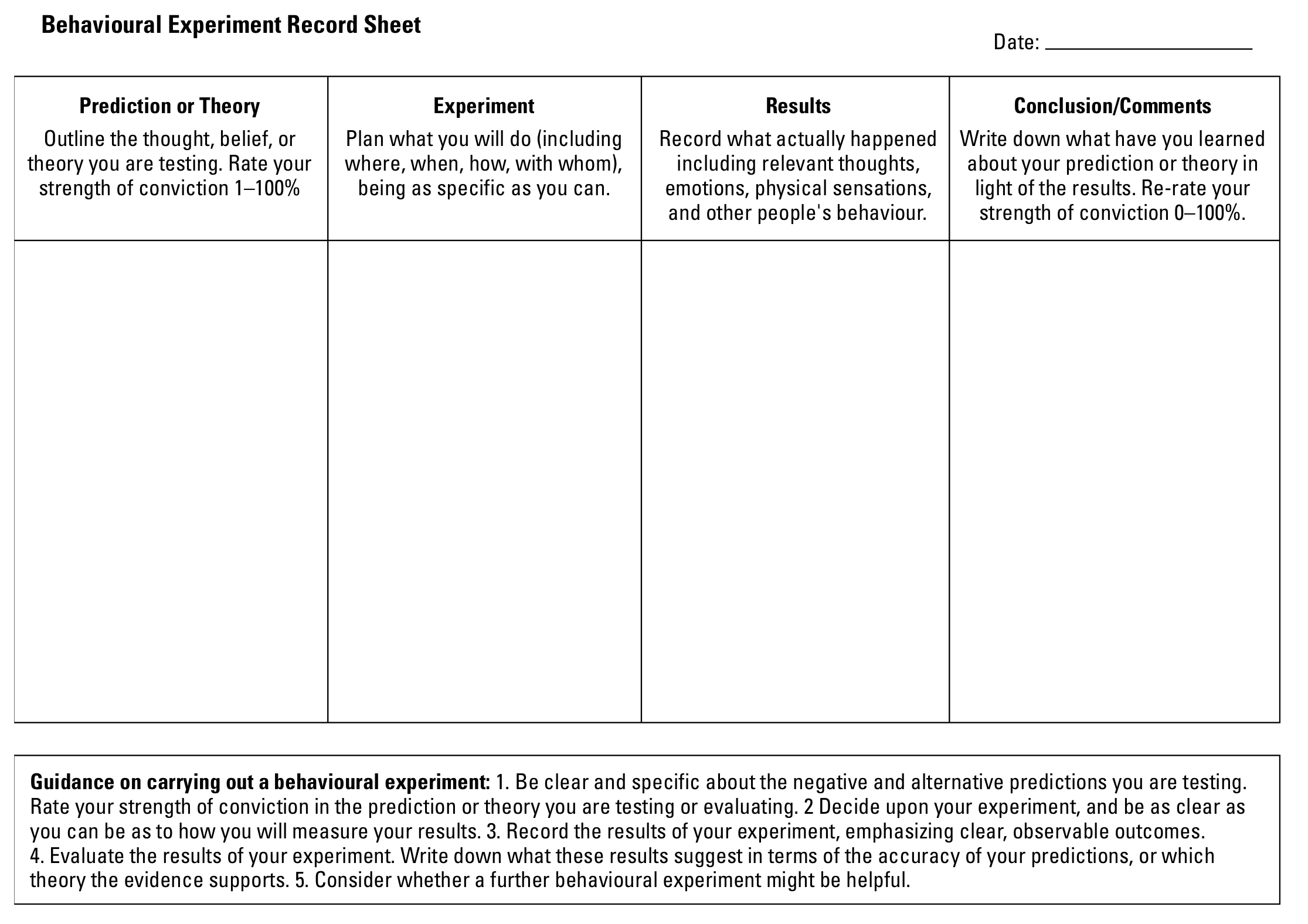
Note: Can we take a moment and remember why I fell in love with statistics? This is amazing :).
Why do we test our fears? To realize that we have nothing to fear but fear itself. Defining what we fear is also the hallmark of a trustworthy man. A man who knows his fears is more trustable than a man who hides from them.
Overtime, as you collect more and more evidence, you naturally adjust your beliefs, principles, and attitude towards the world.
That’s how we can help reduce negative thinking.
There are many ways to experiment as well:
- Field test
- Go out and put your ideas to the test
- Surveys
- Ask around. See what people think. Be like Socrates who would question people out in public
- Observations
- Often being silent can help reveal much of what we overlook on a daily basis
Here are the benefits of running experiments:
- New data gives us the opportunity to change our behavior according to the results of the experiment.
- Experiments helps us realize that many of our negative thoughts and predictions are not accurate in reality
- Having an open mind
- Genuine fearlessness; and the start of living life to the fullest
Chapter 5: Pay Attention! Refocusing and Retraining your Awareness
Summary
Often, it may be our own excessive thinking that’s the problem. Task concentration is the ability to consciously re-focus your attention from inward to outward.
The inner world is emphasized to seek answers, but being outside and observing the world around you can help prevent you from overdoing it.
Task concentration is especially useful when interacting with people, and you may start developing anxiety or self-conscious thinking–when this happens, revert your thinking from inward to outward and focus on the other person.
Chapter Details
This chapter talks briefly about two techniques for managing attention:
- Task concentration
- Mindfulness
I won’t go too much into the weeds on these, because the underlying idea is the same: alternate between focusing on yourself, and focusing on the exterior world.
I personally experienced this when I was living alone. Inside my apartment, my attention would naturally focus on myself, but when I went out for walking breaks, I made a conscious effort to focus externally on the world.
It certainly helped that I lived close to nature in Florida; I could see lush green trees, and I could hear birds singing.
It seems so much of our problems can be solved if we simply took the time to be physical and engage with the real world
Part 2: Charting the Course: Defining Problems and Setting Goals
Identifying the emotion is the first step in ABC because a problem clearly written on paper is half solved; this is one of the instances where emotions do matter, do have a good idea of the precise emotion.
problem-maintaining solutions, such as procrastination or shyness, give us short-term relief, at the cost of long-term solutions when attempting to confront fear in the face of positive change. The key to taking action during hypothesis experimenting is to make it ordinary, leave the ego behind, and simply do it; trust that with time, and a growth mindset, you will eventually win; this is how you become fearless.
The three realities of fear are:
- Your fear event may never actually happen
- If it does happen, you’ll adapt and learn how to cope
- If it does happen, the event may be ephemerally unpleasant, but it is rarely terrible or unbearable
- this too shall pass
Aside from discarding unhealthy core beliefs, CBT is also a practical and flexible method for achieving goals and solving problems.
We redefine SMART goals:
- S: Specific AND positive goal
- M: Measurable
- A: Alignment with principles
- R: Reason, why are we pursing this goal?
- T: Time bound
Cost Benefit Analysis (CBA) for actions and decisions can help us better see the impact of our decision across different levels.
CBA is simply a pros and cons applied to yourself, other people, and the world; doubled to include short-term and long-term consequences. CBA gives us perspective when making decisions.
Remember: Nothing is life is neither good nor bad, it simply is, and it’s net impact (the pros and cons) determine based on where we are in life and what we need
Chapter 6: Exploring emotions
Summary
Emotions do matter in the sense that we should be able to identify them with clarity. Identifying the specific emotion is the first step in ABC, and a problem clearly written on paper is half solved
Chapter Details
Most of this chapter was pretty meta; it introduced ways of looking at our emotions, and how some can be contructive or self-punishing.
Naming your emotions as they arrive is a practical tip when dealing with negative emotions.
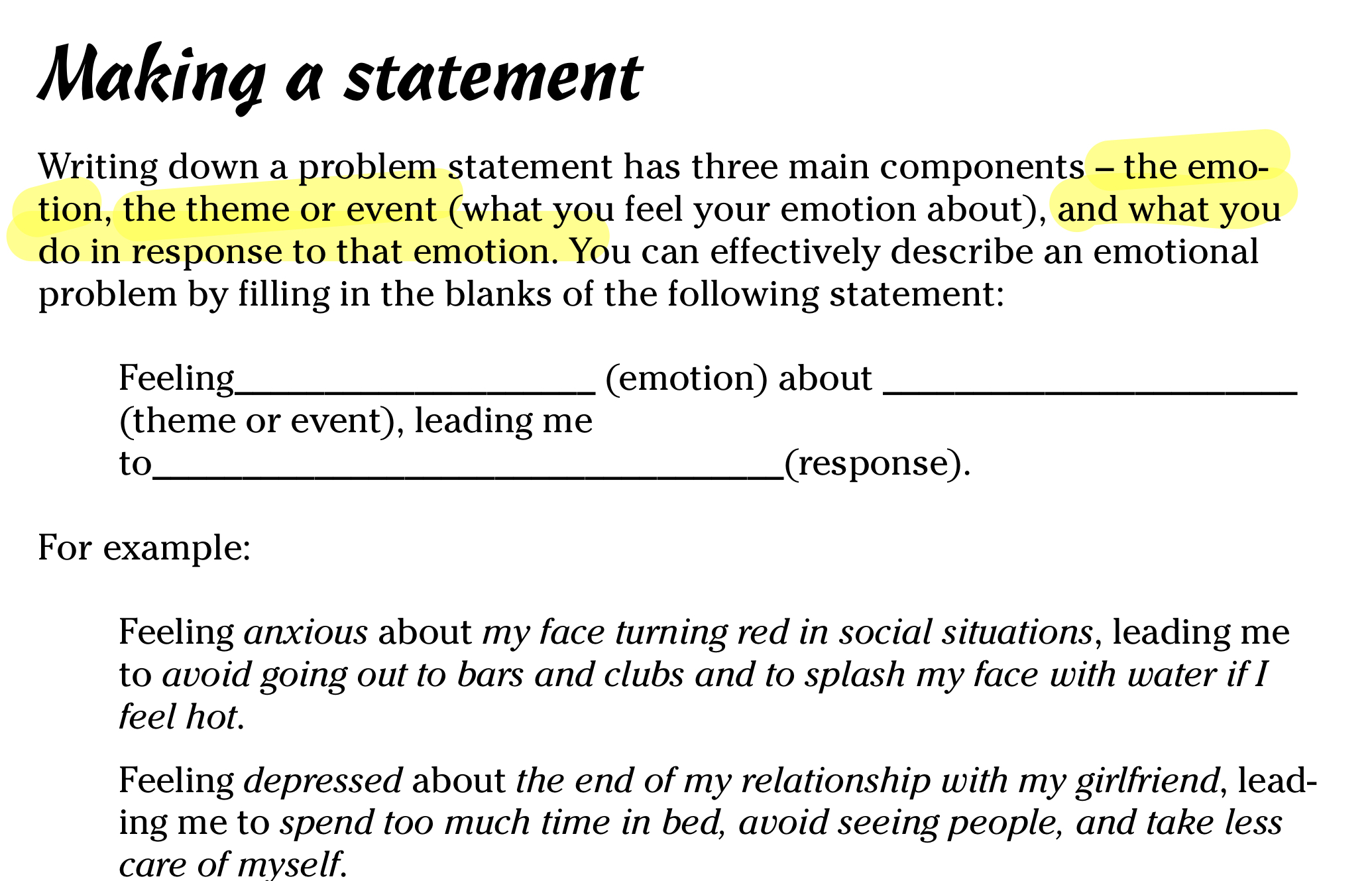
I will say that one of the more useful details is the framing of the problem statement (see above image). Like discussed in chapter 4, when designing experiments to confront our fears, this template works well in the first step, when we define the problem.
This is because it not only reveals the issue at hand, but the associated emotions involved, as well as the corresponding behavior. Really advance stuff, but useful if you really want to get to the root of the issue.
Chapter 7: Identifying Solutions that Cause You Problems
Summary
Certain coping skills can act as a crutch against our self-development. These problem-maintaining solutions give us short-term relief, at the cost of long-term solutions.
Behaviors like procrastination or going through extreme lengths to hide my human flaws all take away my power to living my full potential.
But the key to taking action, especially when conducting uncomfortable experiments, is to make it ordinary, leave the ego behind, and simply do it; trust that with time, and a growth mindset, you will eventually win.
Learning to make taking action ordinary, and leaving your ego behind allows you to take down each of your fears, to one day become truly fearless just like some of your greatest heros; you literally have it inside of you to become just like your heros.
The three realities of fear are:
- Your fear event may never actually happen
- If it does happen, you’ll adapt and learn how to cope
- If it does happen, the event may be ephemerally unpleasant, but it is rarely terrible or unbearable
- this too shall pass
Routines are not superstitious rituals if (1) they have a productive intent (2) we allow for some flexibility (e.g. if I miss a workout in the morning, I may still continue with the rest of my day)
Chapter Details
This chapter starts by detailing the ideal of problem-maintaining solutions–these are safety behaviors that make us feel at ease in the moment, but simply sweep the issue under the rug.
There were two such solutions that I especially cling to:
- Concealing aspects of myself that cause shame
- Especially in high school, I did a lot to protect my ego by making it seem like I was perfect. Granted, I was focused, but I also lacked so much in other areas of my life.
- Putting off dealing with problems or tasks until you’re in the mood
- This is a new one for me in early adulthood. I am surprisingly lazy despite having strong desires to earn more money.
- This is not good, because often undone tasks weigh heavily on my mind–they take away from my peace of mind
- again, tying back to the first point, I often avoid asking questions to make it appear as though I know what I’m doing
The trick to many of these issues is simply stop trying so hard, and be where you are now, knowing that you will get better.
- don’t force it
- don’t strain for it
- don’t try for it
- Simply do it, and put in the time
There’s also the idea of certainty. Some things are possible, and maybe even likely to happen, but that does not make them certain, and it’s how I respond to when something “reliable” breaks down on me that determines how well I can handle uncertainty.
The book also mentions a few other unusual behaviors, such as superstitious rituals. Though for myself, I often wonder what the difference is between being consistent on a routine and habit, and following a ritual.
According to ChatGPT,
The key difference between the two is that consistent routines are based on practical reasons and are chosen intentionally, while superstitious rituals are often based on unfounded beliefs and are performed without any clear purpose or intention. Additionally, consistent routines can be adjusted or changed as needed, while superstitious rituals may be seen as necessary to maintain a sense of control or stability.
In other words, routines are not superstitious rituals if (1) they have a productive intent (2) we allow for some flexibility (e.g. if I miss a workout in the morning, I may still continue with the rest of my day)
Another important note to make is that on fear. This chapter has a brief section that clearly outlines many of the realities of fears. Three of which that stood out to me were:
- Your fear event may never happen
- If it does happen, you’ll adapt and learn how to cope
- The event may be ephemerally unpleasant, but it is rarely terrible or unbearable
In other words, grow a pair.
Chapter 8: Setting your Sights on Goals
Summary
Aside from discarding unhealthy core beliefs, CBT is also a practical and flexible method for achieving goals and solving problems.
We redefine SMART goals:
- S: Specific AND positive goal
- M: Measurable
- A: Alignment with principles
- R: Reason, why are we pursing this goal?
- T: Time bound
Cost Benefit Analysis (CBA) for actions and decisions can help us better see the impact of our decision across different levels.
CBA is simply a pros and cons applied to yourself, other people, and the world; doubled to include short-term and long-term consequences. CBA gives us perspective when making decisions.
Remember: Nothing is life is neither good nor bad, it simply is, and it’s net impact (the pros and cons) determine based on where we are in life and what we need
Chapter Details
The purpose of therapy is is to help you achieve your goals. CBT is a pragmatic and flexible approach to both dealing with problems and setting goals.
This chapter brings up the SPORT acronym for goal setting. While most of us know SMART goals, let’s find define our goal that takes the best from both:
- Specific AND Positively stated goal
- by positive, I mean stating things in the affirmative, rather than the negative
- think “I will buy my first house” rather than “I will not continue to depend on my parents”
- Measurable
- Include a pass/fail mark
- Be proud with failure, because it means you are moving closer to what you actually need!
- Time Bound
- Related to measurable
- Note that you may have an “epic” or goal than spans many months, and then tasks, which span 1 week
- In both cases, the goal is time bounded, and gives us an opportunity to adjust the course if we fail to meet our deadline
- Why
- Remind yourself why you developed the goal in the first place!
- Not only will this prevent you from quitting, but it will also be something to look forward to!
Similar to how we defined frameworks for emotional thinking traps, we may also set frameworks for defining the problem and goal.
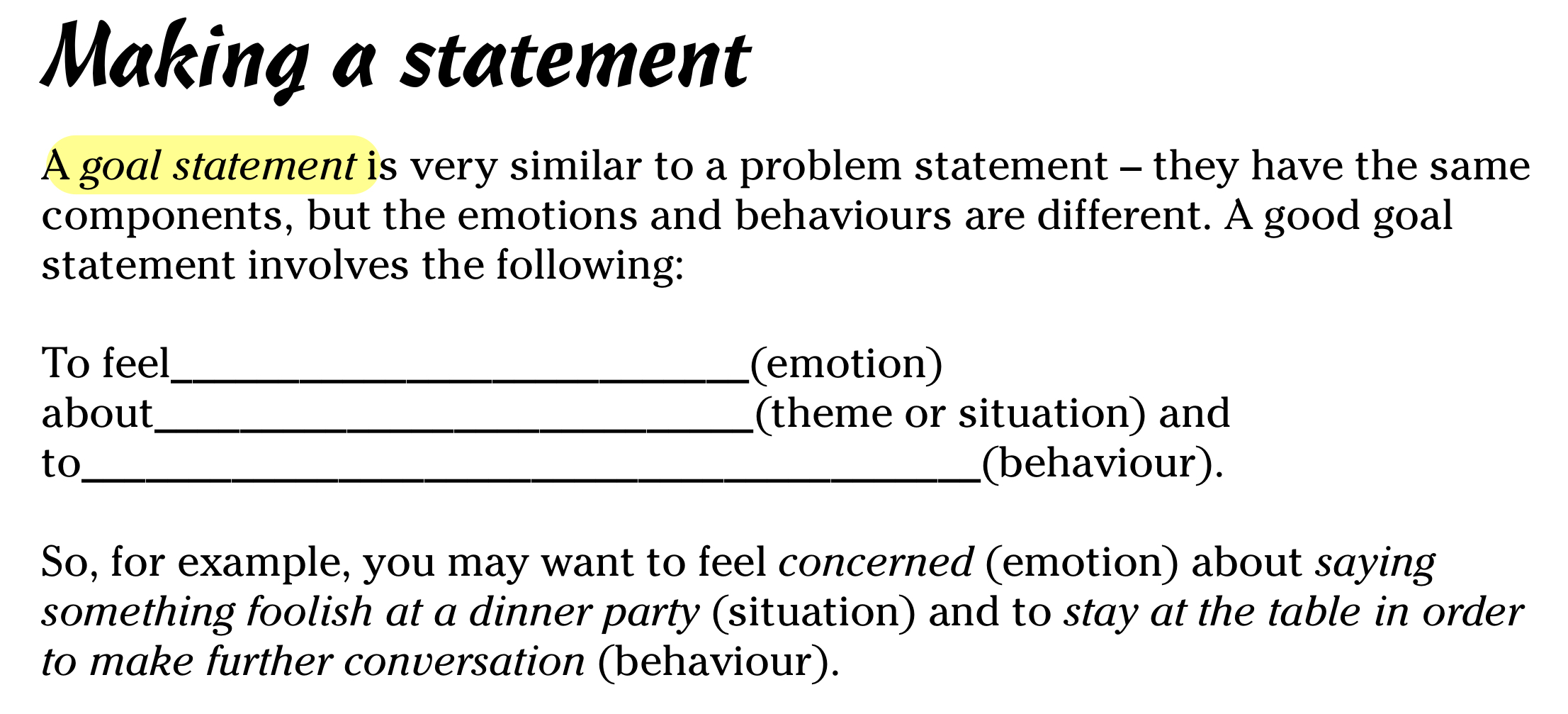
I think this framework would work well when first defining the goal at large, but to keep it simple, I think I’d stick with the 4-part method previously defined.
We then discuss the Cost Benefit Analysis (CBA) for actions can help us better see the impact of our decision across different levels.
This framework is quite simple. It’s a standard pros and cons list, but we mark down the pros and cons across the following categories
- In the short-term
- In the long-term
- For myself
- For others
This helps give us perspective on the situation.
Remember: Nothing is life is neither good nor bad, it simply is, and it’s net impact (the pros and cons) determine based on where we are in life and what we need
Most importantly, we MUST stop expecting grand changes, and instead be flexible enough to make small, compounding changing over time. That’s how we win, and that’s the secret.
Part 3: Putting CBT into Action
The antidote to fear is exposure–make your fear ordinary through habituation. The antidote to depression is action and a healthy routine.
We think the way we feel. The meanings we assign to events have a great deal to do with how we ultimately feel about those events. Likewise, meaning is attached to the names we call ourselves. Fortunately, we can choose what messages we give ourselves, and therefore choose how we think and feel about ourselves.
It’s all about taking personal responsibility for your thoughts, feelings, and actions. You are in the driver’s seat, and that’s the best news.
Understand that, as a human, you will make mistakes, choosing to label your entire self based on a few mistakes is not an accurate endpoint for self-improvement.
Anger is a loss of control; learn how to deal with people. People will always exist in society, they have a right to exist in your world, and they have a right to act stupid. I have a whole set of principles on dealing with people; refer to that list.
Chapter 9: Standing Up to Anxiety and Facing Fear
Summary
The antidote to fear is exposure–make your fear ordinary through habituation.
Chapter Details
This chapter focus on confronting fear.
First understand that we have nothing to fear but fear itself.
So many people suffer in imagination because our feelings are greatly influenced by how we think. We have a tendency to overestimate the probability of bad things happening, and waste valuable time worrying about things that will never happen.
Should we find ourselves anxious or nervous, what should we do?
Nothing.
Feel anxiety, then let it pass, without fighting it.
While this may seem easier said than done, it is, like everything else in life, a habit that can be developed.
How do we strengthen this happen? Through exposure therapy.
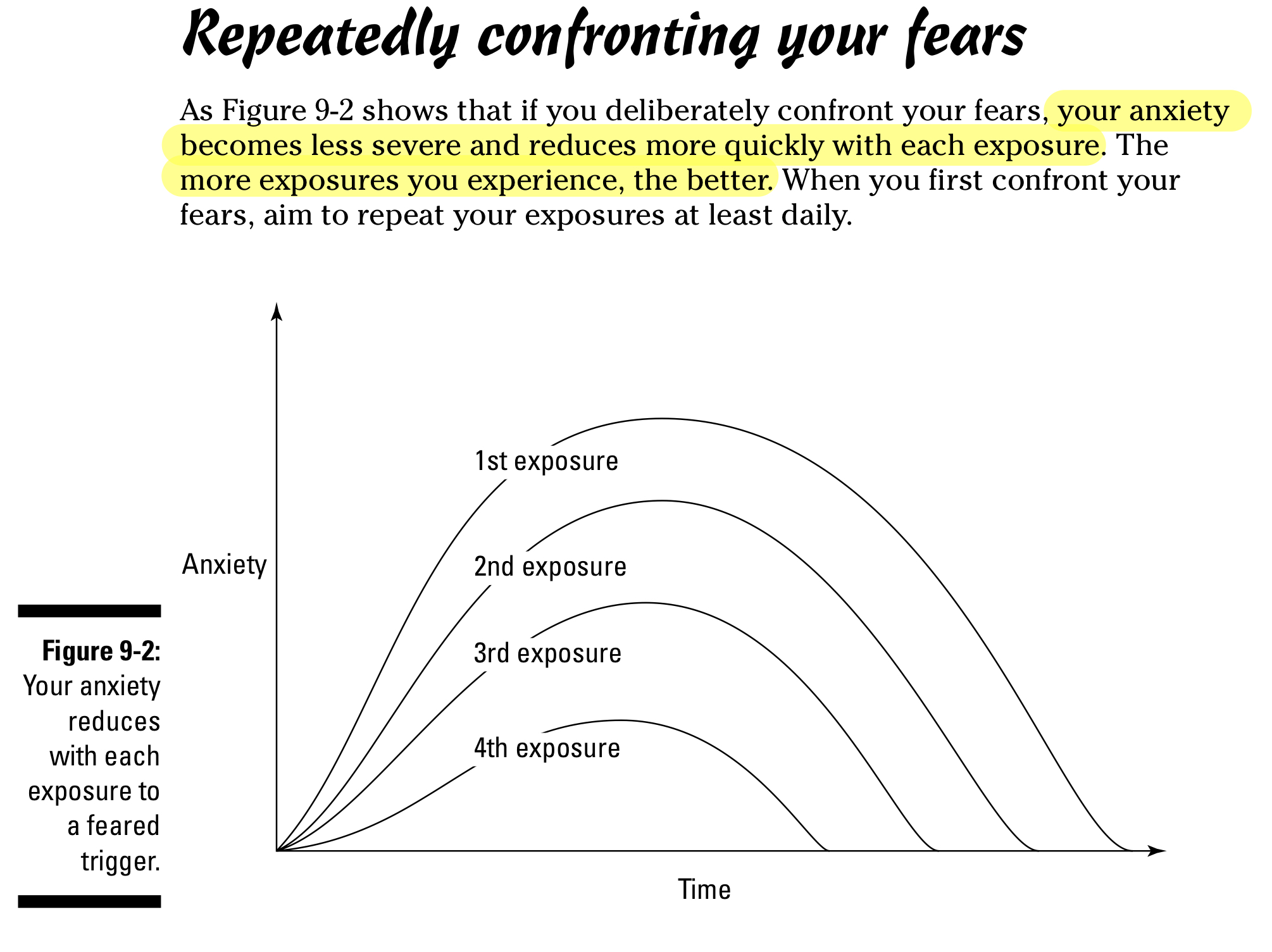
Your anxiety becomes less severe and reduces quickly with each exposure. This is how we ACTUALLY become fearless. It’s not rocket science–it’s habituation.
How we proceed with exposure will vary, but the general rule is that slow is fast–start with an exposure that’s manageable; it’s it’s too easy, you can ramp up, it’s it’s too overwhelming, you can dial down. Then, iterate until your fear becomes ordinary.
This will help prove that you can still take action, despite feeling anxious.
This chapter also mentions the use of a graded hierarchy of fears, and then try to take on the biggest fear you can. When you have confronted the fear, rate your actual level of anxiety following the exposure. Nine times out of ten, it’s often less than the predicted anxiety level. (think back to hypothesis testing and experimentation a few chapters before)
Just as we may shed old personalities, we may too shed fears.
Keep a record of your fears, and systematically make a plan to conquer them all. Sooner or later, the habit of doing scary shit will be ordinary.
Chapter 10: Deconstructing and Demolishing Depression
Summary
The antidote to depression is action. It helps to have a healthy self-care routine (meditation , exercise, healthy food, etc.) to that your depression is not the result of simple fixes.
Chapter Details
As the title suggests, we cover depression and how to recover from it.
I’ve personally been depressed before. Super depressed. This was after moving away from home and going all-in on my career, only to become burned-out from work, isolated in a small town, and feeling like I was losing touch with how to act human (mind you, I was working in an area that felt like 90% of scientists lived there). This was made worse when I visited my brother in Philadelphia, and I saw how much bette his life was.
By chance, when I visited my brother, I found a book titled Instant analysis Book by David J. Lieberman on the shelf of a hotel room, and I instantly found the answer I needed:
Suicide is a permanent solution to a temporary issue.
The book is such a fantastic read for anyone, because it covers so many insightful questions that EVERYONE finds themselves thinking.
From that point, I never considered suicide again. But I was still sad.
The best way to deal with depression is to quite simply have a healthy routine in place. The first four hours of my day are dedicated to optimizing my well being through: - exercise - healthy eating - meditation - goal reminders - mantras - prayer - reading
It’s so simple, but these habits help keep me on track on what I really want in life, and help prevent me from slipping into depression.
Something that the book mentioned is rumination, which I tend to struggle a bit.
But honestly, there’s really only 1 solution to ending rumination or even depression: ACTION!
Chapter 11: Overcoming Obsessions
Summary
I did not spend too much time reading this chapter, but at a glance, it seems to cover some pretty good topics.
Chapter Details
Chapter 12: Overcoming Low Self-esteem by Accepting Yourself
Summary
We think the way we feel. The meanings we assign to events have a great deal to do with how we ultimately feel about those events. Likewise, meaning is attached to the names we call ourselves. Fortunately, we can choose what messages we give ourselves, and therefore choose how we think and feel about ourselves.
It’s all about taking personal responsibility for your thoughts, feelings, and actions. You are in the driver’s seat, and that’s the best news.
Understand that, as a human, you will make mistakes, choosing to label your entire self based on a few mistakes is not an accurate endpoint for self-improvement.
I remember when I was living in a different city, and I changed units within my apartment complex, I would sometimes go to the old unit instead of my new one. However, with this mistake, I did not beat myself up over it–I didn’t even give it much thought other than “whoops, I made a wrong turn”.
Just like that example, I will relapse when changing habits, but that does not make me a loser as a whole person, because I am in the changing phase.
Chapter Details
Self-acceptance is an alternative to boosting self-esteem and tackles the problem by removing self-rating. Labeling yourself makes you feel worse, and can lead to counter unhealthy behaviors.
Here are the principles of self-acceptance
- Understand that you, and every single person around you, has worth because you are human
- Appreciate that you’re too complex to globally measure or rate
- We have the capacity to work on correcting less desirable behaviors and maximizing more desirable ones through a growth mindset
- Labeling is not helpful because WE WILL make mistakes, but it’s realize that one mistake out of a sea of lessons learned does not define us
- Acknowledge your ever-changing nature
- The only constant in life is change
- Consider yourself as a work-in-progress at any given time, a life-long student, and hold a flexible attitude towards yourself
- Accepting your fallible nature
- I am human, so I will make mistakes, and that’s okay because I am anti-fragile
- Valuing your uniqueness
- No one has the exact same upbringing as I do; I am really my own comparison group (Jordan Peterson)
- Using self-acceptance to aid self-improvement
- If and when you make a mistake, take it as it is, and learn from it, objectively, without assigning a label to yourself or your experience
- Understand that acceptance doesn’t mean giving up
- Acceptance is the honest and accurate perspective we have on ourselves
- When we are honest with ourselves, we are in a position to accurately improve
We think the way we feel.
The meanings we assign to events have a great deal to do with how we ultimately feel about those events. Likewise, meaning is attached to the names we call ourselves. Fortunately, we can choose what messages we give ourselves, and therefore choose how we think and feel about ourselves.
we can choose what messages we give ourselves, and therefore choose how we think and feel about ourselves.
Understand that most people call themselves stupid or idiots over one mistake. In reality, my one action may be silly, but it does not make me dumb.
My one action may be silly, but it does not make me dumb.
It’s all about taking personal responsibility for your thoughts, feelings, and actions. You are in the driver’s seat, and that’s the best news.
Chapter 13: Cooling Down Your Anger
Summary
Learn how to deal with people. People will always exist in society, they have a right to exist in your world, and they have a right to act stupid. I have a whole set of principles on dealing with people; refer to that list.
Chapter Details
This chapter can be summarized by one sentence:
learn how to deal with people.
That’s the crux of life. Here’s why:
- People will always exist in society
- People have a right to exist in your world
- People have a right to act stupid and be upset
It comes down to these basic points: (1) how well can you avoid toxic people? (2) how can you make yourself less toxic, so that people do not become upset with you?
Outside of people, we may be stressed by other things.
But realize that:Most things are difficult to bear and inconvenient, rather than unbearable and absolutely terrible. This too shall pass.
And that’s it!
If you wish to reduce your stress, understand these two things:
- how to work well with people
- this too shall pass
Part 4: Looking Backwards and Moving Forwards
Core beliefs are living organisms that drive our behaviors.
Generating alternatives for your unhealthy and absolute core beliefs is not about positive thinking or platitudes, rather about generating less absolute, more accurate, more realistic opinions about yourself, other people, and the world around you.
This actual process of cultivating a new path is ACTING!
ACTING, ACTING, ACTING!!!
It’s time to go to court, and you get to collect as much positive evidence as possible. Get so much evidence, it would be silly for the jury to consider the null hypothesis.
Which situations should you seek?
The situation that freaks you out if you were still operating under your old beliefs. GO THERE
You may relapse and fail. That’s okay, old paths are easy and familiar today, but with time, you will have a new, better path.
Have hobbies to collect the evidence of your alternative hypothesis.
Chapter 14: Taking a Fresh Look at Your Past
Summary
This chapter is all about core beliefs.
Core beliefs are the corner stone that underpins our habits. Core beliefs are the perspectives we hold on ourselves, other people, and the world around us.
Core beliefs are like living organisms in our mind.
Negative core beliefs feed on negative perspective, reject positive alternatives, and even try to distort positive evidence–they are parasites.
Positive core beliefs are like planting oak trees that give life to compounding good qualities–they are a source of power.
Generating alternatives for your unhealthy and absolute core beliefs is not about positive thinking or platitudes, rather about generating less absolute, more accurate, more realistic opinions about yourself, other people, and the world around you.
old beliefs are like well trodden paths through an overgrown field. Expect to “fail” and relapse while you cultivate new paths simply because they’re easier and more well known today. But, as with all things, time heals and paves the path to better core beliefs. Be nice to yourself on the instance where you relapse.
Chapter Details
CBT actually considers the past an important aspects of understanding one’s problems by specifically investigating past experiences to see how these early events may still be affecting people in their present lives.
Our past experiences have an effect on how we think and function now
We may all be carrying wounds by unpleasant events into our present and future (AKA, baggage)
Core beliefs are called core because they’re deeply held ideas and they’re at the very center of our belief system; they give rise to rules, demands, or assumptions, which in turn produce automatic thoughts
All core beliefs influence how we interact with three aspects of daily life:
- Beliefs about ourselves
- negative thoughts may lead one to self-sabotage opportunities
- positive thoughts may lead to one to make the most of life
- Beliefs about other people
- negative thoughts may lead to isolation and hostility
- positive thoughts may lead to newfound friends, family, and mastermind
- Beliefs about the world
- negative thoughts see only poverty and unfairness
- positive thoughts see the abundance in the world
Identifying core beliefs about yourself can help you understand why you keep having the same problems
Often, core beliefs are hard to define because they’re not clear statements in our head. This chapter reveals five approaches to identify core beliefs
- Downward Arrow
- Identify a situation that causes you to have an unhealthy negative emotion, then ask yourself: “what does this say about me?
- Keep going down the arrow with each belief, constantly asking yourself the meaning, until you reach a point where you can no longer think beyond the meaning–that’s the core belief
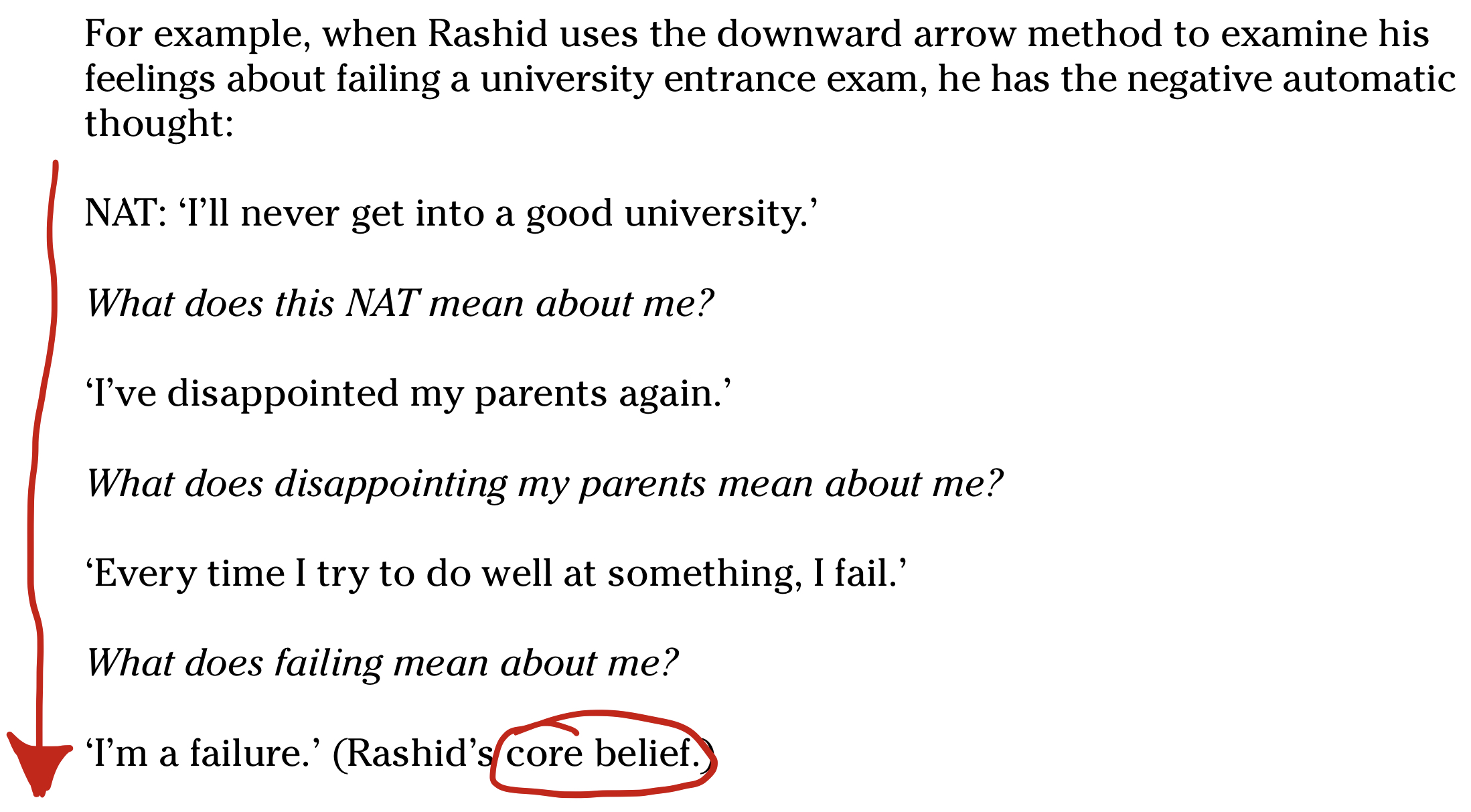
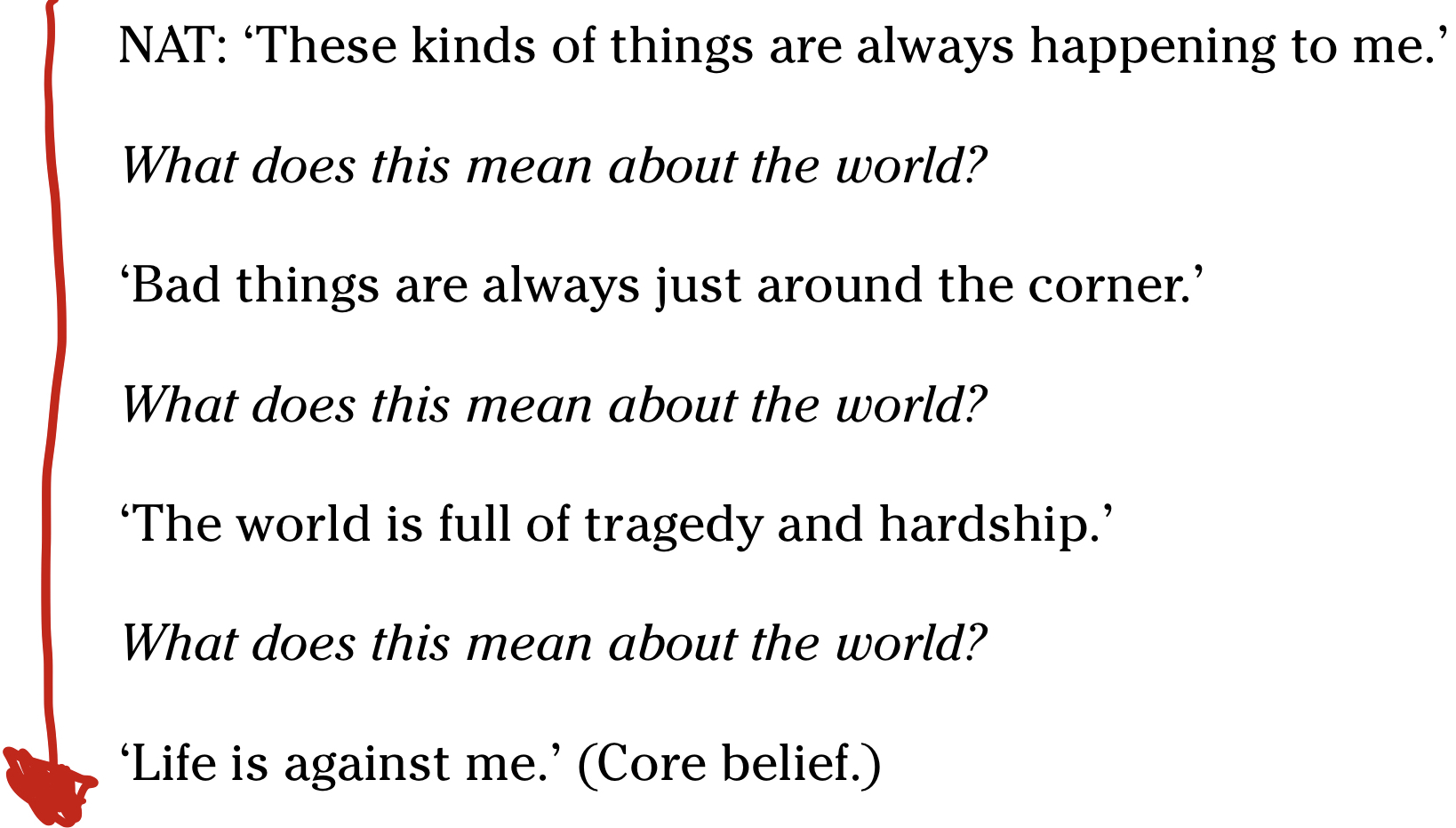
-
Nightmares
- This technique is the same as arrow, but focuses on fictional, but visceral, dreams, instead of real-life events
- ask yourself what this dream means about you, people, and the world
- often useful if you constantly find yourself imagining the worst-case scenario or have reoccurring nightmares
-
Tracking Themes
- This is a general, wide-view approach that works well after many ABCs have been applied
- essentially, look as your past ABCs and determine a consistent theme that’s present
- same idea: what does this theme say about me, people, and the world?
-
Filling in the Blanks
- Blunt, straightforward method
- grab a piece of paper, and complete the blanks:
- “I am —-”
- “Other people are —”
- “The world is —”
- often good if you find yourself in a rut and need to mentally dump your thoughts
-
Fill out the template
- This is a pretty easy-to-follow format that works pretty quick
- After competing the form, answer these final questions:
- What is my negative core belief?
- How does this negative core belief affect the way I interpret events?
- How do I tend to act when the core belief is triggered? What is the negative behavior?
- What is a more unbiased, accurate interpretation of these events?
- What alternative behavior may be more productive?
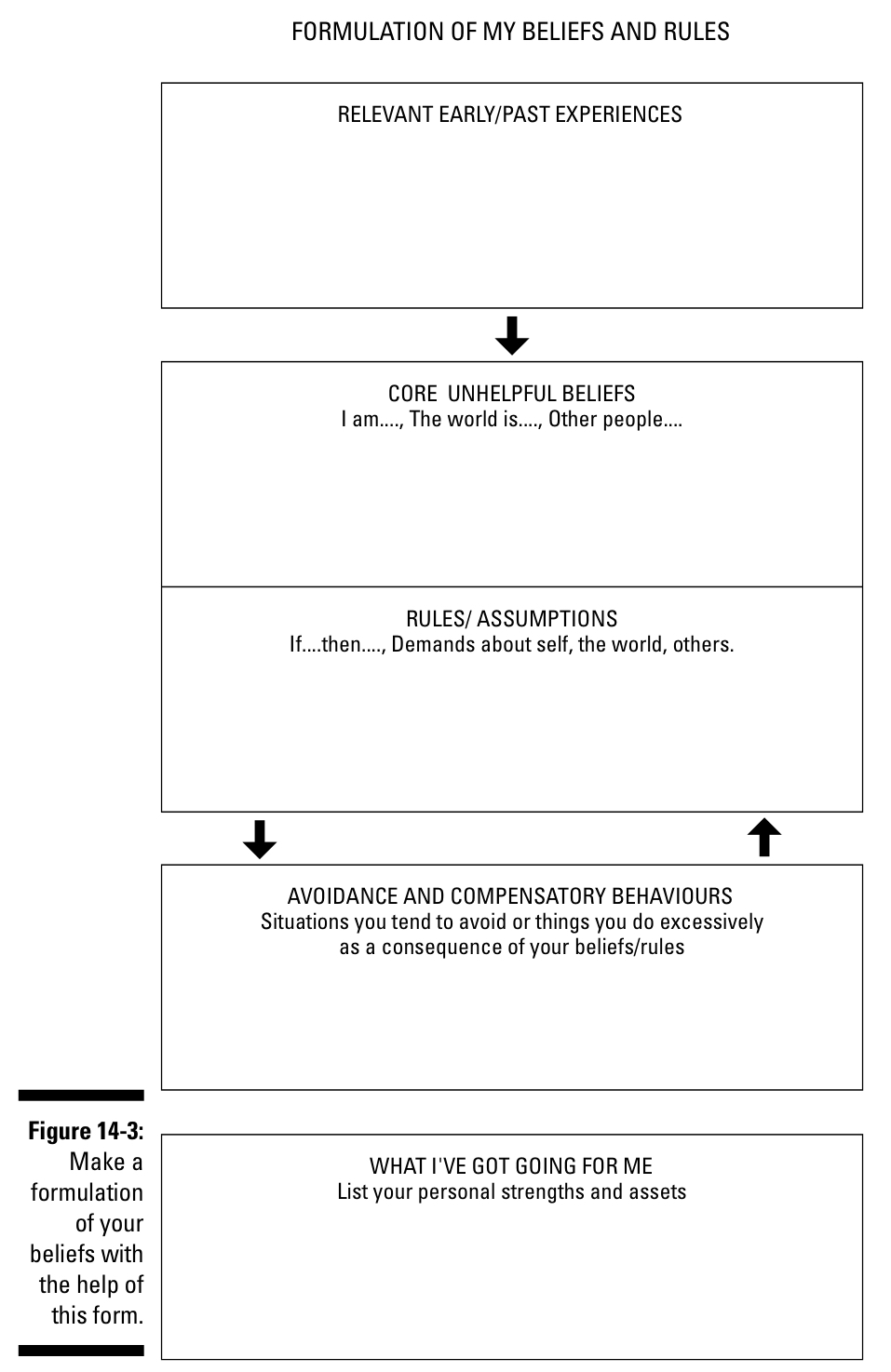
Whichever method you choose, always answer in the context of the big three:
- myself
- other people
- the world
Why are core beliefs so important?
Core beliefs drive behavior
- Positive core beliefs lead to positive behaviors
- negative core beliefs lead to negative behaviors
- honest core beliefs lead to honest behaviors
- deceptive core beliefs lead to deceptive behaviors
To evaluate whether your core beliefs are unhealthy, you must pay attention to your corresponding behaviors
Ask yourself: “are you acting the way your ideal potential would act?”
I personally love the examples the chapter provides. For example:
“Milo operates according to his core belief about being unlovable; he behaves in ways that actually tend to drive his partners away from him. Milo doesn’t yet see that his core belief, and corresponds insecure behavior, is what causes problems in his relationships. Instead, Milo thinks that each time a partner leaves him for someone else, it is further evidence that his core belief of ‘I am unlovable’ is true”
we act in accordance to our core beliefs
The nature of unhealthy core beliefs
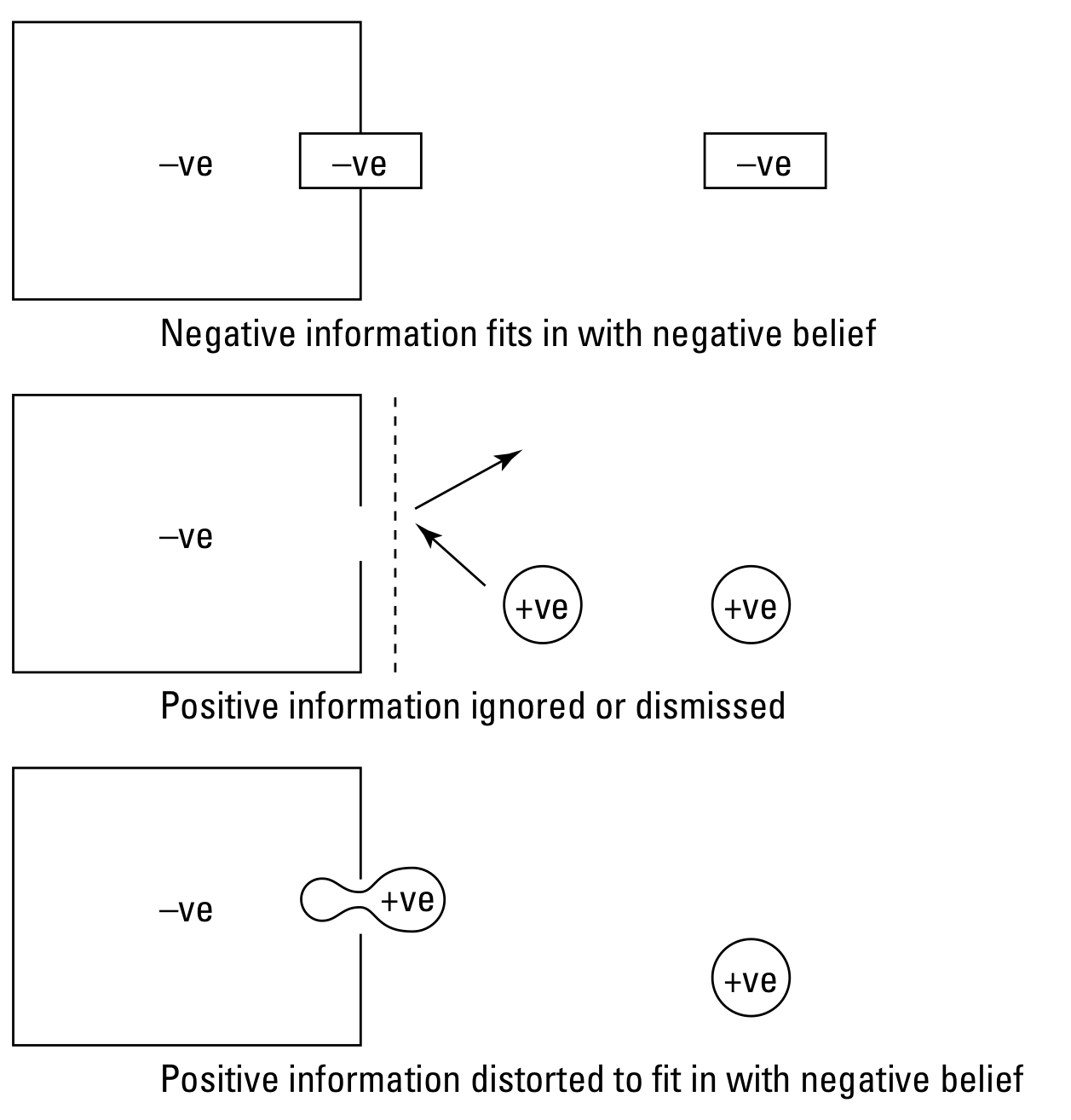
Unhealthy core beliefs are like living organisms; they feed on negativity, reject positivity, and may even distort positivity (as shown in above image)
The good news
A problem written down is half solved; knowing the unhealthy core belief puts you in a position to develop healthier alternatives, which is the other half
generating alternatives for your unhealthy and absolute core beliefs is not about positive thinking or platitudes, rather about generating less absolute, more accurate, more realistic opinions about yourself, other people, and the world around you.
Final thoughts on developing new core beliefs
old beliefs are like well trodden paths through an overgrown field.
Developing new core beliefs, and acting them through behavior, will be hard work, but trust that with time, anything can be fixed, and you will have a life like never before.
You will be tempted to walk on the old paths because they’re easier and more well known–you may even “fail” a few times.
Persist. And eventually your new path will be far more familiar.
Treat yourself like the little brothers you watch over.
Chapter 15: Moving New Beliefs from your Head to your Heart
Summary
This actual process of cultivating a new path is ACTING!
ACTING, ACTING, ACTING!!!
It’s going to feel weird and awkward, and that’s okay, keep at it!
It’s time to go to court, and you get to collect as much positive evidence as possible. Get so much evidence, it would be silly for the jury to consider the null hypothesis.
If you’re really, really serious about making your new beliefs stick, you can seek out situations that put them to the test.
Which situations should you seek?
The situation that freaks you out if you were still operating under your old beliefs. GO THERE
Chapter Details
The point of CBT is to integrate your new, healthy methods of thinking with your mind, emotions, and *actions.
Usually, when you fix your mind, the rest will follow through.
This chapter mentions the importance of ACTING, which is similar to what Earl Nightingale mentioned.
ACTING, ACTING, ACTING!!!.
Actions speak louder than words.
It’s time to collect the evidence to support your new view, and this can be done by putting yourself out there and taking action. Try to find evidence that your belief is accurate.
Imagine you’re about to go into court to present to the jury arguments in defense of your new belief. Develop as many good arguments that support your new belief as you can by collecting evidence through action
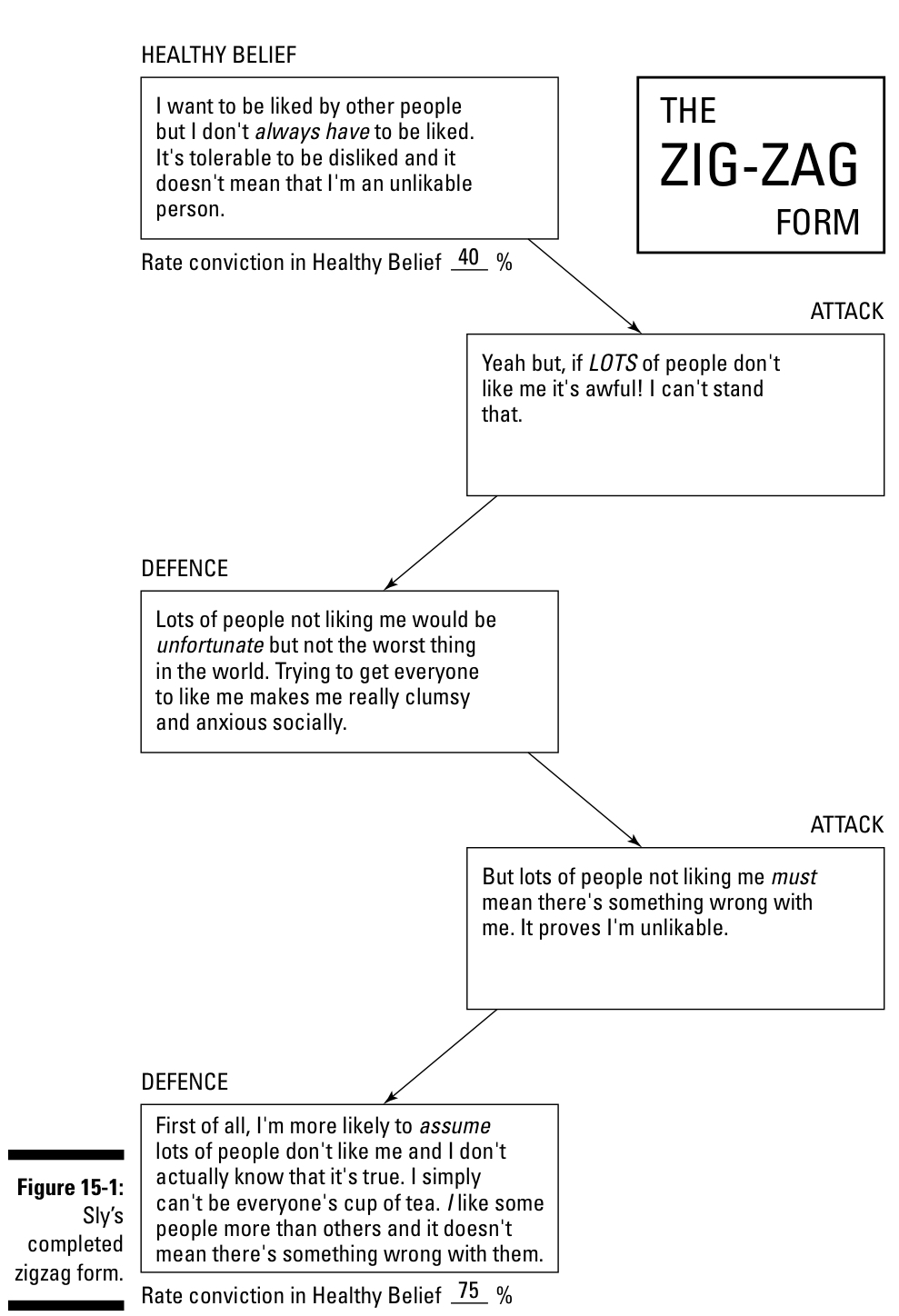
You will often have doubts. Write them down, on paper, just like the zig-zag method above, and stress-test your thinking.
If you’re really, really serious about making your new beliefs stick, you can seek out situations that put them to the test.
Which situations should you seek?
The situation that freaks you out if you were still operating under your old beliefs. GO THERE
Chapter 16: Heading for a Healthier and Happier Life
Summary
Have hobbies that match to the evidence you wish to collect. Go out and interact with people and the world!
Chapter Details
This chapter talks about the importance of having hobbies, which I certainly agree with.
Personally speaking, since this is my blog, I want to do the following hobbies:
- Brazilian jiu-jitsu / boxing
- Salsa Dancing
- Acting classes/Improv
- Comedy club
- Golf
- Spanish speaking classes
- Yoga
- cross fit
- volunteering (nursing home)
I want to do the above specifically because they involve working with other people, while increasing my social confidence to be outside.
Write down a plan.
Then do it.
DO IT!
Chapter 17: Overcoming Obstacles to Progress
Summary
This chapter talks about overcoming obstacles while developing your new path.
Look, you will relapse a few times, and that’s okay. Get up, and move forward. It’s that simple.
Chapter Details
Chapter 18: Psychological Gardening: Maintaining your CBT Gains
Summary
Not to much to comment on this chapter. It’s again all about maintaining momentum on your goals.
Chapter Details
Chapter 19: Working with Professionals
Summary
I skimmed this section before, but it’s not something I’m personally interested in.
Chapter Details
Part 5: The Part of Tens
Chapter 20: Ten Healthy Attitudes for Living
This chapter lays out 10 rules/commandments that will only improve your life.
Read them, re-read them, think them through, and put them to the test through action.
- You Feel the way you think
- As ye show, so shall ye reap
- Think Flexibly
- Think non-dualistically
- It’s neither good nor bad, but simply is, and net effects change with time
- Valuing your individuality
- You can be both socially intregated and true to your values by accepting yourself as an individual and by being a selective conformist
- Accepting that life can be unfair
- But it’s the pursuit that makes it fun
- If shit happens, ask yourself: “what are you doing to do about it?”
- Understand that approval from others isn’t necessary
- People will come and go from your life
- Put yourself first
- Realizing Love’s desirable, but not Essential
- Love first starts from within, at the individual level, and then stills outwardly, to be shared and amplified with others
- to access this internal love reservoir, simply take action towards your goals
- Tolerating short-term discomfort
- This too shall pass
- Enacting Enlightened Self-Interest
- Put yourself #1; you will often be alone, and it’s your life, so do what you want
- Pursing Interest and Acting Consistent with your Values
- Write down your principles
- Read your principles
- Respond to all things through your principles
- Tolerate Uncertainty
- Take calculated risks and experiments, but don’t avoid risk, because the only thing that’s certain in life is death
Chapter 21: Ten Self-Esteem Boosters That Don’t Work
We know the 10 things to do, so now here are the 10 things to not do.
- Putting others down
- Though I think I don’t do this, I think it’s important for me to realize that people may not be thinking about the same things I do
- I’m not smarter than someone else just because I know something technical, I’m simply knowledgeable in one area of my life
- If I’m so smart, then when not teach the person what I know for free?
- Thinking you’re special
- I fell into this trap, and I learned my lesson
- I’m an ordinary guy who is humble to learn as much as I can
- Trying to get everyone to like you
- Do good work, rather than simply being a good person
- Be someone of value first
- Placing Yourself above criticism
- Avoiding Failure, Disapproval, Rejection, and the like
- I struggle with this a lot because I don’t want to hurt my image
- Then I realized: my 20s are the best time to look stupid
- Avoiding your emotions
- I’m guilty of this as well–suppressing and compartmentalizing
- My emotions simply reflect my thinking
- Emotions also come and go
- Attempting to feel more significant by controlling others
- Over-defending your self-worth
- Find a healthy balance between being a doormat and being aggressive
- Feeling Superior
- Again, treat everyone as an equal; it does not cost me anything to show respect to anyone; we are all born with respect
- Blaming Nature or Nurture for your problems
- I hate to admit this, but I made this mistake
- I am forever grateful of my upbringing
Chapter 22: Ten Ways to Lighten Up
- Accept that you can, and will, make mistakes
- Try something new
- Stamp on Shame
- Laugh at yourself
- Don’t take offense so easily
- Make good use of criticism
- if it’s true, why should it bother you?
- use it as self-improvement!
- Settle into Social Situations
- Encourage your creativity to flow
- Act Adventurously
- Enjoy yourself: It’s your life!
Chapter 23: Ten Books to Add to Your Library
- “Cognitive Therapy - Basics and Beyond”, by Judith S. Beck
- “Cognitive Therapy and the Emotional Disorders”, by Aaron T. Beck
- “Full Catastrophe Living”, by Jon Kabat-Zinn
- “Overcoming” book series, by Robinson Press
- “Overcoming Anger”, by Windy Dryden
- “Oxford Guide to Behavioral Experiments in Cognitive Therapy”, by James Bennett-Levy
- “Reason and Emotion in Psychotherapy”, by Dr. Albert Ellis
- “Reinventing your life”, by Jeffrey E. Young
- “Status Anxiety”, by Alain De Botton
- “A woman in your own right”, by Anne Dickson
